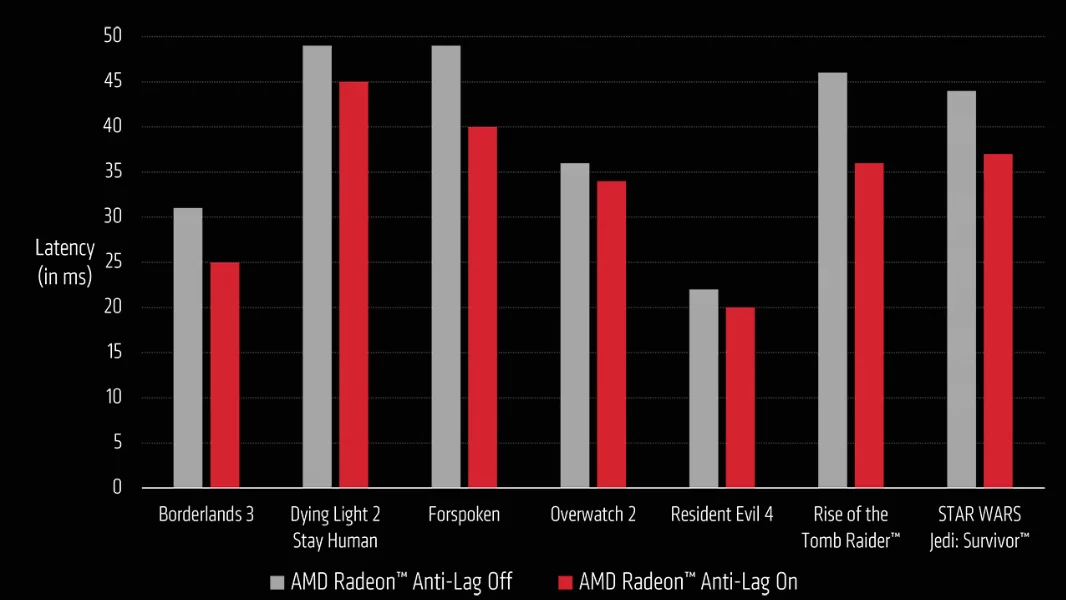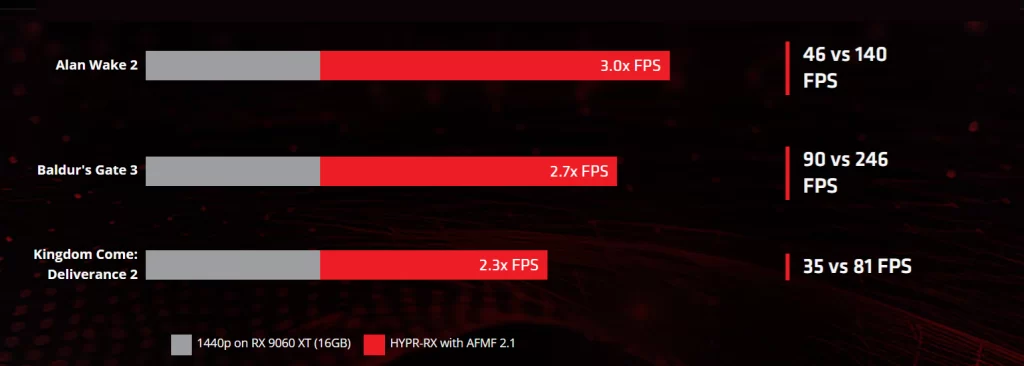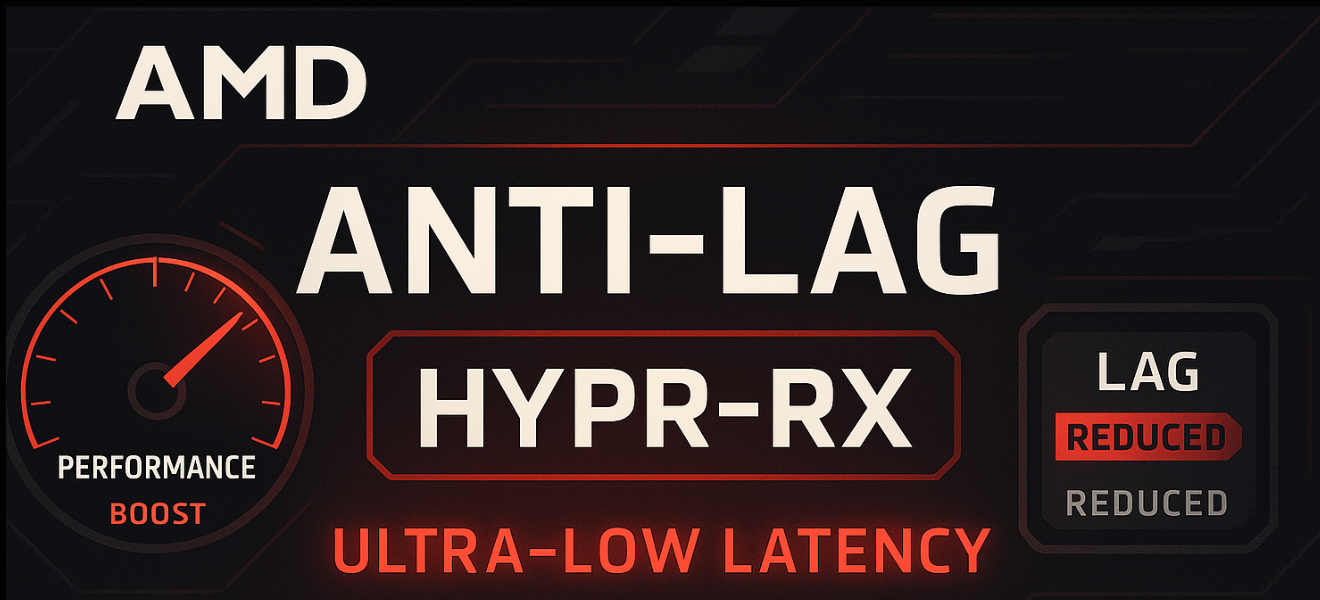During gameplay, not only accuracy but also speed of response is crucial. If the system doesn’t react in time, every move can come too late, which will greatly affect the entire experience. AMD’s Anti-Lag and HYPR-RX technologies are designed to minimize lag, improve smoothness, and ensure the system responds quickly to your every input, without the need for lengthy setup. Just activate them and you’ll feel the difference immediately.
What is AMD Anti-Lag and how does it work?
AMD Anti-Lag solves a common but often overlooked problem and that is the delay between your input (mouse movement, keystroke) and the response of the image on the screen. It is this delay that can make the difference in competitive, action-packed games as to whether or not you can react in time. Normally, the graphics card tries to maintain smoothness by preparing more frames ahead of time. While this does improve image stability, it also increases latency and therefore the time it takes for your movement to be reflected on the screen. AMD Anti-Lag interferes with this process so that the graphics card only generates the frames that are really needed. This dramatically reduces system response time and ensures that your every move is reflected in the game faster and more accurately.

The result? Judge for yourself. This chart compares latency (delay in milliseconds) for different games with AMD Anti-Lag technology enabled and disabled. The grey bars show latency without Anti-Lag, while the red bars show latency with Anti-Lag enabled. So the chart shows that this technology reduces latency directly in games by an average of 6-7ms. Anti-lag or Anti-lag 2 will make it a little bit more so it will be even more milliseconds in the result.
AMD FreeSync and AMD Anti-Lag may look very similar to some of you. Maybe they do, but in reality they are solving completely different things. AMD FreeSync takes care of image smoothness, that is, it synchronizes the monitor’s frequency with the graphics card’s output, preventing tearing and choppiness. The result is a smoother visual experience, especially at fluctuating FPS. AMD Anti-Lag, on the other hand, reduces the time between your input (mouse, keyboard) and the on-screen response. So you’ll react sooner in fast-paced games, which can make the difference between winning and losing. Simply put: AMD FreeSync improves what you see, AMD Anti-Lag improves how quickly you can react to it. Together, they create a gaming experience that’s not only smooth, but fast.
Anti-Lag vs
The base version is available for most Radeon graphics cards from the RX 5000 series and up. It is activated directly in the AMD Adrenalin software and works reliably without the need for complex setup. It is designed for gamers who want to reduce lag and get faster response in the widest possible range of games. For a complete list of graphics cards supporting Anti-Lag just click here. And in case you don’t know what graphics card you own, help yourself to our article to find out correctly.
Anti-Lag is an enhanced version designed for newer models such as the Radeon RX 7000 series and above. Unlike the basic version, it works directly with the data in the graphics card driver, allowing it to more accurately control the flow of frames between the processor and the graphics card. The result is even lower latency without negatively impacting image quality or performance. However, it only works in supported games where this level of optimization can be used to its full potential.
And for those of you who require sub-data directly in various games, you can watch this video:
Summary:
- Anti-Lag: Simple and widely available solution, works in most games regardless of card model (from RX 5000 upwards).
- Anti-Lag : More advanced technology for the latest cards, with even lower response and higher accuracy – but requires support from the game.
Anti-Lag 2 – even faster response, safely and reliably
The latest version of AMD Anti-Lag 2 saw the light of day in June 2024 in response to the need for even more accurate and secure technology to reduce latency in games. It was developed in response to feedback from the community, particularly after problems with Anti-Lag in some online games. Anti-Lag 2 works directly with game developers, meaning that it is integrated into the game itself and does not interfere with its protection mechanisms.
And what does this latest version bring? An even lower response rate than basic Anti-Lag or Anti-Lag , but without the risk of disconnects or bans in competitive games.
This technology is so far only available in a few supported titles such as Counter-Strike 2, where AMD Anti-Lag 2 significantly reduces input latency without affecting the fair-play system. If you play fast-paced FPS games, this is exactly the kind of difference that can make the difference in your victory.
What is HYPR-RX and why is it worth using?
AMD HYPR-RX is a smart solution that allows you to get more performance out of your build without complex settings. Think of it as a quick switch that activates several performance technologies at once with a single click. Their common goal is to improve smoothness, shorten response time and increase image quality without having to manually adjust anything.
HYPR-RX combines three key technologies from AMD:
- AMD Anti-Lag: Reduces the delay between your input (e.g. mouse movement) and the on-screen response. This gives you the feeling that the game is responding instantly, which is especially key in fights or fast-paced scenes.
- Radeon Boost: Monitors the speed of in-game motion and when it detects intense action (e.g. fast camera movement), it temporarily lowers the resolution to free up performance. The result? Better smoothness when you need it most, without even noticing it visually.
- Radeon Super Resolution (RSR): Allows you to play at a lower resolution, but enlarges the resulting image using a proprietary algorithm to make it look sharp and detailed – just like native high resolution. In practice, this means more performance without a significant loss in image quality.
Each of these technologies works independently, but when you combine them via HYPR-RX, they start working together as one coherent whole. Anti-Lag makes for faster system response, Radeon Boost dynamically adjusts the resolution according to what’s happening on screen, and RSR ensures that the resulting image is sharp and visually appealing. Combined, they create a sophisticated system that automatically balances performance, smoothness and image quality to ensure you get the most out of your setup without having to adjust anything.
You don’t need technical expertise or time spent in setup to use HYPR-RX. Just open the AMD Adrenalin software, activate HYPR-RX and everything else will happen automatically. The system adapts to the game you’re playing and makes sure you enjoy it with better response, smoother movement and a high-quality image – without any unnecessary effort.
Where does HYPR-RX work?
AMD HYPR-RX is part of the Adrenaline Edition software and designed to be accessible to everyone. If you’re using a Radeon graphics card from recent years and have Windows 10 or 11, you’re all set. HYPR-RX supports a wide range of cards and works across AMD’s entire modern portfolio, so you’ll be able to use it seamlessly on your build.
With HYPR-RX working with technologies like Anti-Lag and Radeon Boost that are optimized for DirectX 11 and 12, you’ll be able to use it in most modern games, whether it’s the latest title or a proven classic. The technologies automatically adapt to the game you’re playing and make sure it runs faster, responds better and looks sharper.

Here’s how AMD HYPR-RX technology takes gaming performance to a whole new level. On a Radeon RX 9060 XT graphics card (16GB), it can more than double the FPS in games like Alan Wake 2, Baldur’s Gate 3 and Kingdom Come: Deliverance 2. For example, Alan Wake 2 jumped from 46 to a whopping 140 FPS. The result? Smoother visuals, faster reactions, and a much better gaming experience without having to change hardware.
Conclusion
If you’re looking for a way to get faster response times, smoother images, and a better gaming experience without having to invest in a new graphics card, AMD Anti-Lag and HYPR-RX are exactly what you need. Both technologies work together, are easy to activate and require no complicated setup. Just click and you’ll feel the difference immediately.
Whether you play competitively or enjoy gaming in your spare time, these tools will help you react faster, control the game more accurately, and get the most out of your build. If you have an AMD Radeon graphics card, you already have everything you need. Just turn on HYPR-RX, let Anti-Lag do its job – and the game will finally start working the way it should.
